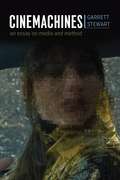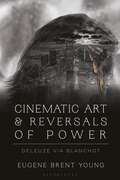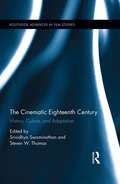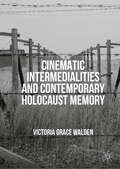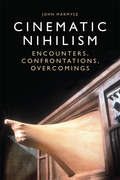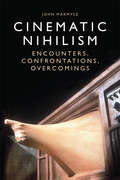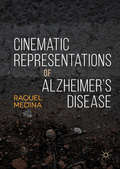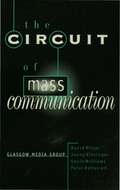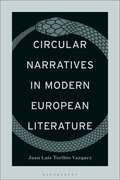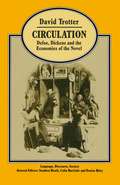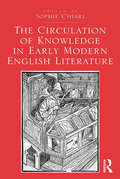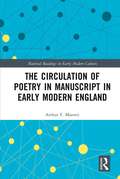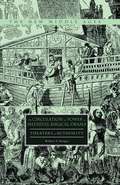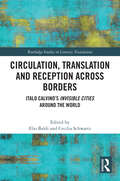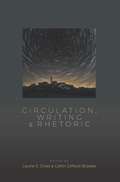- Table View
- List View
Cinemachines: An Essay on Media and Method
by Garrett StewartThe hero stands on stage in high-definition 3-D while doubled on a crude pixel screen in Billy Lynn’s Long Halftime Walk. Alien ships leave Earth by dissolving at the conclusion of Arrival. An illusory death spiral in Vertigo transitions abruptly to a studio set, jolting the spectator. These are a few of the startling visual moments that Garrett Stewart examines in Cinemachines, a compelling, powerful, and witty book about the cultural and mechanical apparatuses that underlie modern cinema. Engaging in fresh ways with revelatory special effects in the history of cinematic storytelling—from Buster Keaton’s breaching of the film screen in Sherlock Jr. to the pixel disintegration of a remotely projected hologram in Blade Runner 2049—Stewart’s book puts unprecedented emphasis on technique in moving image narrative. Complicating and revising the discourse on historical screen processes, Cinemachines will be crucial reading for anyone interested in the evolution of the movies from a celluloid to a digital medium.
Cinemachines: An Essay on Media and Method
by Garrett StewartThe hero stands on stage in high-definition 3-D while doubled on a crude pixel screen in Billy Lynn’s Long Halftime Walk. Alien ships leave Earth by dissolving at the conclusion of Arrival. An illusory death spiral in Vertigo transitions abruptly to a studio set, jolting the spectator. These are a few of the startling visual moments that Garrett Stewart examines in Cinemachines, a compelling, powerful, and witty book about the cultural and mechanical apparatuses that underlie modern cinema. Engaging in fresh ways with revelatory special effects in the history of cinematic storytelling—from Buster Keaton’s breaching of the film screen in Sherlock Jr. to the pixel disintegration of a remotely projected hologram in Blade Runner 2049—Stewart’s book puts unprecedented emphasis on technique in moving image narrative. Complicating and revising the discourse on historical screen processes, Cinemachines will be crucial reading for anyone interested in the evolution of the movies from a celluloid to a digital medium.
Cinemachines: An Essay on Media and Method
by Garrett StewartThe hero stands on stage in high-definition 3-D while doubled on a crude pixel screen in Billy Lynn’s Long Halftime Walk. Alien ships leave Earth by dissolving at the conclusion of Arrival. An illusory death spiral in Vertigo transitions abruptly to a studio set, jolting the spectator. These are a few of the startling visual moments that Garrett Stewart examines in Cinemachines, a compelling, powerful, and witty book about the cultural and mechanical apparatuses that underlie modern cinema. Engaging in fresh ways with revelatory special effects in the history of cinematic storytelling—from Buster Keaton’s breaching of the film screen in Sherlock Jr. to the pixel disintegration of a remotely projected hologram in Blade Runner 2049—Stewart’s book puts unprecedented emphasis on technique in moving image narrative. Complicating and revising the discourse on historical screen processes, Cinemachines will be crucial reading for anyone interested in the evolution of the movies from a celluloid to a digital medium.
Cinemachines: An Essay on Media and Method
by Garrett StewartThe hero stands on stage in high-definition 3-D while doubled on a crude pixel screen in Billy Lynn’s Long Halftime Walk. Alien ships leave Earth by dissolving at the conclusion of Arrival. An illusory death spiral in Vertigo transitions abruptly to a studio set, jolting the spectator. These are a few of the startling visual moments that Garrett Stewart examines in Cinemachines, a compelling, powerful, and witty book about the cultural and mechanical apparatuses that underlie modern cinema. Engaging in fresh ways with revelatory special effects in the history of cinematic storytelling—from Buster Keaton’s breaching of the film screen in Sherlock Jr. to the pixel disintegration of a remotely projected hologram in Blade Runner 2049—Stewart’s book puts unprecedented emphasis on technique in moving image narrative. Complicating and revising the discourse on historical screen processes, Cinemachines will be crucial reading for anyone interested in the evolution of the movies from a celluloid to a digital medium.
Cinemachines: An Essay on Media and Method
by Garrett StewartThe hero stands on stage in high-definition 3-D while doubled on a crude pixel screen in Billy Lynn’s Long Halftime Walk. Alien ships leave Earth by dissolving at the conclusion of Arrival. An illusory death spiral in Vertigo transitions abruptly to a studio set, jolting the spectator. These are a few of the startling visual moments that Garrett Stewart examines in Cinemachines, a compelling, powerful, and witty book about the cultural and mechanical apparatuses that underlie modern cinema. Engaging in fresh ways with revelatory special effects in the history of cinematic storytelling—from Buster Keaton’s breaching of the film screen in Sherlock Jr. to the pixel disintegration of a remotely projected hologram in Blade Runner 2049—Stewart’s book puts unprecedented emphasis on technique in moving image narrative. Complicating and revising the discourse on historical screen processes, Cinemachines will be crucial reading for anyone interested in the evolution of the movies from a celluloid to a digital medium.
Cinematic Art and Reversals of Power: Deleuze via Blanchot
by Eugene B. YoungBringing together Deleuze, Blanchot, and Foucault, this book provides a detailed and original exploration of the ideas that influenced Deleuze's thought leading up to and throughout his cinema volumes and, as a result, proposes a new definition of art. Examining Blanchot's suggestion that art and dream are “outside” of power, as imagination has neither reality nor truth, and Foucault's theory that power forms knowledge by valuing life, Eugene Brent Young relates these to both Deleuze's philosophy of time and his work with Guattari on art. In doing so, he uses case studies from literature and popular film, including Kafka's Castle, Villeneuve's Arrival, and Kubrick's Eyes Wide Shut. Providing important new insights for those working in literary and cinematic studies, this book advances a new definition of art as that which reverses the realities and truths of power to express obscure ideas and values beyond both our exterior and interior worlds.
Cinematic Art and Reversals of Power: Deleuze via Blanchot
by Eugene B. YoungBringing together Deleuze, Blanchot, and Foucault, this book provides a detailed and original exploration of the ideas that influenced Deleuze's thought leading up to and throughout his cinema volumes and, as a result, proposes a new definition of art. Examining Blanchot's suggestion that art and dream are “outside” of power, as imagination has neither reality nor truth, and Foucault's theory that power forms knowledge by valuing life, Eugene Brent Young relates these to both Deleuze's philosophy of time and his work with Guattari on art. In doing so, he uses case studies from literature and popular film, including Kafka's Castle, Villeneuve's Arrival, and Kubrick's Eyes Wide Shut. Providing important new insights for those working in literary and cinematic studies, this book advances a new definition of art as that which reverses the realities and truths of power to express obscure ideas and values beyond both our exterior and interior worlds.
The Cinematic Eighteenth Century: History, Culture, and Adaptation (Routledge Advances in Film Studies)
by Srividhya Swaminathan Steven W. ThomasThis collection explores how film and television depict the complex and diverse milieu of the eighteenth century as a literary, historical, and cultural space. Topics range from adaptations of Austen’s Sense and Sensibility and Defoe's Robinson Crusoe (The Martian) to historical fiction on the subjects of slavery (Belle), piracy (Crossbones and Black Sails), monarchy (The Madness of King George and The Libertine), print culture (Blackadder and National Treasure), and the role of women (Marie Antoinette, The Duchess, and Outlander). This interdisciplinary collection draws from film theory and literary theory to discuss how film and television allows for critical re-visioning as well as revising of the cultural concepts in literary and extra-literary writing about the historical period.
The Cinematic Eighteenth Century: History, Culture, and Adaptation (Routledge Advances in Film Studies)
by Srividhya Swaminathan Steven W. ThomasThis collection explores how film and television depict the complex and diverse milieu of the eighteenth century as a literary, historical, and cultural space. Topics range from adaptations of Austen’s Sense and Sensibility and Defoe's Robinson Crusoe (The Martian) to historical fiction on the subjects of slavery (Belle), piracy (Crossbones and Black Sails), monarchy (The Madness of King George and The Libertine), print culture (Blackadder and National Treasure), and the role of women (Marie Antoinette, The Duchess, and Outlander). This interdisciplinary collection draws from film theory and literary theory to discuss how film and television allows for critical re-visioning as well as revising of the cultural concepts in literary and extra-literary writing about the historical period.
Cinematic Intermedialities and Contemporary Holocaust Memory
by Victoria Grace WaldenThis book explores the growing trend of intermediality in cinematic representations of the Holocaust. It turns to the in-betweens that characterise the cinematic experience to discover how the different elements involved in film and its viewing collaborate to produce Holocaust memory. Cinematic Intermedialities is a work of film-philosophy that places a number of different forms of screen media, such as films that reassemble archive footage, animations, apps and museum installations, in dialogue with the writing of Deleuze and Guattari, art critic-cum-philosopher Georges Didi-Huberman and film phenomenologies. The result is a careful and unique examination of how Holocaust memory can emerge from the relationship between different media, objects and bodies during the film experience. This work challenges the existing concentration on representation in writing about Holocaust films, turning instead to the materials of screen works and the spectatorial experience to highlight the powerful contribution of the cinematic to Holocaust memory.
Cinematic Nihilism: Encounters, Confrontations, Overcomings
by John MarmyszOffers a new understanding of empathy and its relation to medicine and literature
Cinematic Nihilism: Encounters, Confrontations, Overcomings
by John MarmyszDefines the interdisciplinary field of Rural Modernity through analysis of British literature, art and culture
Cinematic Representations of Alzheimer’s Disease
by Raquel MedinaThis book offers a cross-cultural approach to cinematic representations of Alzheimer’s disease in non-mainstream cinema. Even though Alzheimer’s disease, the most common form of dementia, is a global health issue, it is not perceived or represented homogenously around the world. Contrary to very well-known mainstream films, the films discussed do not focus on the negative aspects normally associated with Alzheimer’s disease, but on the importance of portraying the perspective of the persons living with Alzheimer’s and their personhood. Similarly, this book analyses how the films use Alzheimer’s as a trope to address issues relating to different areas of life and society such as, for example, family matters, intergenerational relationships, gender issues, national traditions versus global modernity, and caring for people with dementia. By examining an array of films, from crime fiction to documentary, that each present non-stigmatising representations of Alzheimer’s disease, this in-depth study ultimately demonstrates the power of culture in shaping meaning.
The Circuit of Mass Communication: Media Strategies, Representation and Audience Reception in the AIDS Crisis (PDF)
by Peter Beharrell David Miller Professor Jenny KitzingerThis book moves beyond the narrow focus of much of the work on media and cultural studies to examine the whole process of interaction between the media and the social world. Rejecting approaches which focus only on ownership or discourse or audience reception, this new book from the Glasgow Media Group, examines: promotional strategies; media production; representation and audience responses; as well as broader impacts on policy, culture and society. Using a detailed analysis of the struggle over representation during the AIDS crisis as point of departure, The Circuit of Mass Communication reveals the power of the media to influence public opinion, and the complex interaction between media coverage, audience response and contemporary power relations. Based on extensive empirical research, this book offers a range of challenging insights on media power, active audiences and moral panics.
Circular Narratives in Modern European Literature
by Juan Luis Toribio VazquezBreaking with linearity – the ruling narrative model in the Jewish-Christian tradition since the ancient world – many 20th-century European writers adopted circular narrative forms. Juan Luis Toribio Vazquez shows this trend was not a unified nor conscious movement, but rather a series of works arising sporadically in different countries at different times, using a variety of circular structures to express similar concerns and ideas about the world. This study also shows how the renewed understanding of narrative form leading to this circular trend was anticipated by Nietzsche's critiques of truth, knowledge, language and metaphysics, and especially by his related discussions of nihilism and the eternal recurrence.Starting with an analysis of the theory and genealogy of linear narrative, the author charts the emergence of Nietzsche's idea of eternal return, before then turning to the history of the circular narrative trend. This history is explored from its inception, in the works of August Strindberg, Gertrude Stein and Azorín; through its development in the interwar years, by writers such as Raymond Queneau and Vladimir Nabokov; to its full flowering in the work of authors James Joyce or Samuel Beckett, among others; and its later employment by post-war writers, including Alain Robbe-Grillet, Italo Calvino and Maurice Blanchot. Through a series of close readings, the book aims to highlight the various ways in which narrative circularity serves to break with an essentially teleological and theological thinking. Finally, Toribio Vazquez concludes by proposing a new typology of non-linear narratives, which builds on the work of recent narratologists.
Circular Narratives in Modern European Literature
by Juan Luis Toribio VazquezBreaking with linearity – the ruling narrative model in the Jewish-Christian tradition since the ancient world – many 20th-century European writers adopted circular narrative forms. Juan Luis Toribio Vazquez shows this trend was not a unified nor conscious movement, but rather a series of works arising sporadically in different countries at different times, using a variety of circular structures to express similar concerns and ideas about the world. This study also shows how the renewed understanding of narrative form leading to this circular trend was anticipated by Nietzsche's critiques of truth, knowledge, language and metaphysics, and especially by his related discussions of nihilism and the eternal recurrence.Starting with an analysis of the theory and genealogy of linear narrative, the author charts the emergence of Nietzsche's idea of eternal return, before then turning to the history of the circular narrative trend. This history is explored from its inception, in the works of August Strindberg, Gertrude Stein and Azorín; through its development in the interwar years, by writers such as Raymond Queneau and Vladimir Nabokov; to its full flowering in the work of authors James Joyce or Samuel Beckett, among others; and its later employment by post-war writers, including Alain Robbe-Grillet, Italo Calvino and Maurice Blanchot. Through a series of close readings, the book aims to highlight the various ways in which narrative circularity serves to break with an essentially teleological and theological thinking. Finally, Toribio Vazquez concludes by proposing a new typology of non-linear narratives, which builds on the work of recent narratologists.
Circulation: Defoe, Dickens, and the Economies of the Novel (pdf) (Language, Discourse, Society Ser.)
by David TrotterThe Circulation of Knowledge in Early Modern English Literature
by Sophie ChiariWith its many rites of initiation (religious, educational, professional or sexual), Elizabethan and Jacobean education emphasized both imitation and discovery in a struggle to bring population to a minimal literacy, while more demanding techniques were being developed for the cultural elite. The Circulation of Knowledge in Early Modern English Literature examines the question of transmission and of the educational procedures in16th- and 17th-century England by emphasizing deviant practices that questioned, reassessed or even challenged pre-established cultural norms and traditions. This volume thus alternates theoretical analyses with more specific readings in order to investigate the multiple ways in which ideas then circulated. It also addresses the ways in which the dominant cultural forms of the literature and drama of Shakespeare’s age were being subverted. In this regard, its various contributors analyze how the interrelated processes of initiation, transmission and transgression operated at the core of early modern English culture, and how Christopher Marlowe, William Shakespeare and Thomas Middleton, or lesser known poets and playwrights such as Thomas Howell, Thomas Edwards and George Villiers, managed to appropriate these cultural processes in their works.
The Circulation of Knowledge in Early Modern English Literature
by Sophie ChiariWith its many rites of initiation (religious, educational, professional or sexual), Elizabethan and Jacobean education emphasized both imitation and discovery in a struggle to bring population to a minimal literacy, while more demanding techniques were being developed for the cultural elite. The Circulation of Knowledge in Early Modern English Literature examines the question of transmission and of the educational procedures in16th- and 17th-century England by emphasizing deviant practices that questioned, reassessed or even challenged pre-established cultural norms and traditions. This volume thus alternates theoretical analyses with more specific readings in order to investigate the multiple ways in which ideas then circulated. It also addresses the ways in which the dominant cultural forms of the literature and drama of Shakespeare’s age were being subverted. In this regard, its various contributors analyze how the interrelated processes of initiation, transmission and transgression operated at the core of early modern English culture, and how Christopher Marlowe, William Shakespeare and Thomas Middleton, or lesser known poets and playwrights such as Thomas Howell, Thomas Edwards and George Villiers, managed to appropriate these cultural processes in their works.
The Circulation of Poetry in Manuscript in Early Modern England (Material Readings in Early Modern Culture)
by Arthur F. MarottiThis study examines the transmission and compilation of poetic texts through manuscripts from the late-Elizabethan era through the mid-seventeenth century, paying attention to the distinctive material, social, and literary features of these documents. The study has two main focuses: the first, the particular social environments in which texts were compiled and, second, the presence within this system of a large body of (usually anonymous) rare or unique poems. Manuscripts from aristocratic, academic, and urban professional environments are examined in separate chapters that highlight particular collections. Two chapters consider the social networking within the university and London that facilitated the transmission within these environments and between them. Although the topic is addressed throughout the study, the place of rare or unique poems in manuscript collections is at the center of the final three chapters. The book as a whole argues that scholars need to pay more attention to the social life of texts in the period and to little-known or unknown rare or unique poems that represent a field of writing broader than that defined in a literary history based mainly on the products of print culture.
The Circulation of Poetry in Manuscript in Early Modern England (Material Readings in Early Modern Culture)
by Arthur F. MarottiThis study examines the transmission and compilation of poetic texts through manuscripts from the late-Elizabethan era through the mid-seventeenth century, paying attention to the distinctive material, social, and literary features of these documents. The study has two main focuses: the first, the particular social environments in which texts were compiled and, second, the presence within this system of a large body of (usually anonymous) rare or unique poems. Manuscripts from aristocratic, academic, and urban professional environments are examined in separate chapters that highlight particular collections. Two chapters consider the social networking within the university and London that facilitated the transmission within these environments and between them. Although the topic is addressed throughout the study, the place of rare or unique poems in manuscript collections is at the center of the final three chapters. The book as a whole argues that scholars need to pay more attention to the social life of texts in the period and to little-known or unknown rare or unique poems that represent a field of writing broader than that defined in a literary history based mainly on the products of print culture.
The Circulation of Power in Medieval Biblical Drama: Theaters of Authority (The New Middle Ages)
by Robert S. SturgesA literary reading informed by the recent temporal turn in Queer Theory, this book analyzes medieval Biblical drama for themes representing modes of power such as the body, politics, and law. Revitalizing the discussions on medieval drama, Sturges asserts that these dramas were often intended not to teach morality but to resist Christian authority.
Circulation, Translation and Reception Across Borders: Italo Calvino’s Invisible Cities Around the World (Routledge Studies in Literary Translation)
by Elio Baldi Cecilia SchwartzThis volume offers a detailed analysis of selected cases in the reception, translation and artistic reinterpretation of Italo Calvino's Invisible Cities (1972) around the world. The book traces the many different ways in which Calvino's modern classic has been read, translated and adapted in Brazil, France, the Netherlands and Flanders, Mexico, Romania, Scandinavia, the USSR, China, Poland, Japan and Australia. It also offers analyses of the relation between Calvino's book and, respectively, the East and Africa, as well as reflections on the book's inspiration for, and resonance in, dance, architecture and art. The volume thus traces the diversity in the reception and circulation of Invisible Cities in different countries and continents, offering a much wider framework for the discussion of Calvino’s masterpiece than before, and a more detailed picture of its cultural and linguistic ramifications. This book will be of interest to scholars in Comparative Literature, World Literature, Translation Studies, Italian Studies, Romance Languages, European Studies, Dance, Architecture and Media Studies, as well as to scholars specialised in paratext and reception.
Circulation, Translation and Reception Across Borders: Italo Calvino’s Invisible Cities Around the World (Routledge Studies in Literary Translation)
by Elio Baldi Cecilia SchwartzThis volume offers a detailed analysis of selected cases in the reception, translation and artistic reinterpretation of Italo Calvino's Invisible Cities (1972) around the world. The book traces the many different ways in which Calvino's modern classic has been read, translated and adapted in Brazil, France, the Netherlands and Flanders, Mexico, Romania, Scandinavia, the USSR, China, Poland, Japan and Australia. It also offers analyses of the relation between Calvino's book and, respectively, the East and Africa, as well as reflections on the book's inspiration for, and resonance in, dance, architecture and art. The volume thus traces the diversity in the reception and circulation of Invisible Cities in different countries and continents, offering a much wider framework for the discussion of Calvino’s masterpiece than before, and a more detailed picture of its cultural and linguistic ramifications. This book will be of interest to scholars in Comparative Literature, World Literature, Translation Studies, Italian Studies, Romance Languages, European Studies, Dance, Architecture and Media Studies, as well as to scholars specialised in paratext and reception.
Circulation, Writing, and Rhetoric
by Laurie E. Gries Collin Gifford BrookeWhile it has long been understood that the circulation of discourse, bodies, artifacts, and ideas plays an important constitutive force in our cultures and communities, circulation, as a concept and a phenomenon, has been underexamined in studies of rhetoric and writing. In an effort to give circulation its rhetorical due, Circulation, Writing, and Rhetoric introduces a wide range of studies that foreground circulation in both theory and practice. Contributors to the volume specifically explore the connections between circulation and public rhetorics, urban studies, feminist rhetorics, digital communication, new materialism, and digital research. Circulation is a cultural-rhetorical process that impacts various ecologies, communities, and subjectivities in an ever-increasing globally networked environment. As made evident in this collection, circulation occurs in all forms of discursive production, from academic arguments to neoliberal policies to graffiti to tweets and bitcoins. Even in the case of tombstones, borrowed text achieves only partial stability before it is recirculated and transformed again. This communicative process is even more evident in the digital realm, the underlying infrastructures of which we have yet to fully understand. As public spaces become more and more saturated with circulating texts and images and as networked relations come to the center of rhetorical focus, Circulation, Writing, and Rhetoric will be a vital interdisciplinary resource for approaching the contemporary dynamics of rhetoric and writing. Contributors: Aaron Beveridge, Casey Boyle, Jim Brown, Naomi Clark, Dànielle Nicole DeVoss, Rebecca Dingo, Sidney I. Dobrin, Jay Dolmage, Dustin Edwards, Jessica Enoch, Tarez Samra Graban, Byron Hawk, Gerald Jackson, Gesa E. Kirsch, Heather Lang, Sean Morey, Jenny Rice, Thomas Rickert, Jim Ridolfo, Nathaniel A. Rivers, Jacqueline Jones Royster, Donnie Johnson Sackey, Michele Simmons, Dale M. Smith, Patricia Sullivan, John Tinnell, Kathleen Blake Yancey
